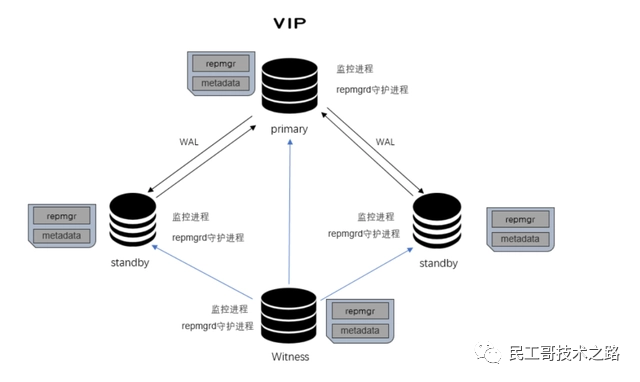进阶数据库系列(十八):PostgreSQL 基于 repmgr 高可用架构实践
点击下方名片,设为星标!回复“1024”获取2TB学习资源!前面介绍了PostgreSQL存储过程、索引、分区分表、事务与并发控制、主从复制、高可用方案、基于 Patroni 高可用架构部署及故障切换等相关的知识点,今天我将详细的为大家介绍 PostgreSQL 基于 repmgr 高可用架构相关知识,希望大家能够从中收获多多!如有帮助,请点在看、转发支持一波!!!PostgreSQL 的开源..
点击下方名片,设为星标!
回复“1024”获取2TB学习资源!
前面介绍了 PostgreSQL 存储过程、索引、分区分表、事务与并发控制、主从复制、高可用方案、基于 Patroni 高可用架构部署及故障切换等相关的知识点,今天我将详细的为大家介绍 PostgreSQL 基于 repmgr 高可用架构相关知识,希望大家能够从中收获多多!如有帮助,请点在看、转发支持一波!!!
PostgreSQL 的开源 HA 工具有很多种,前一章介绍了基于 Patroni 高可用架构的部署与配置,今天来学习另一个轻量级的高可用套件 repmgr。
repmgr 简介
repmgr是一个2ndQuadrant开发的一款复制的开源工具套件,用于管理PostgreSQL服务器集群中的复制和故障转移。最初,它主要是为了简化流副本的管理,后来发展成为一个完整的故障转移管理套件。它通过设置备用服务器,监视复制以及执行管理任务(如故障转移或手动切换操作)的工具,增强了PostgreSQL内置的热备份功能。Repmgr体系架构如下: repmgr与声名远扬的ORACLE ADG逻辑复制工具非常类似。它的功能强大,安装和配置简单,有很强的可操控性。
repmgr与声名远扬的ORACLE ADG逻辑复制工具非常类似。它的功能强大,安装和配置简单,有很强的可操控性。
repmgr特点
repmgr的特点是非常轻量,单功能全面
-
故障检测和自动故障切换:repmgr 可以检测到主服务器故障并自动切换到备用服务器。
-
自动故障恢复:repmgr 可以检测到从服务器故障并自动将其重新加入到复制拓扑中。
-
多个备用服务器:repmgr 支持多个备用服务器,可以在主服务器故障时自动切换到最合适的备用服务器。
-
灵活的复制拓扑:repmgr 支持各种复制拓扑,包括单主服务器和多主服务器。
-
管理和监控:repmgr 提供了用于管理和监控PostgreSQL复制的各种工具和命令。
可以说 repmgr 是一个扩展模块,简化了 PostgreSQL 复制的管理和维护,提高系统的可靠性和可用性。它是一个非常有用的工具,特别是对于需要高可用性的生产环境。同时 repmgr 也是由 Postgresql 社区开发以及维护的。
它提供了两个主要工具:
repmgr
#用于执行管理任务的命令行工具 设置备用服务器,将备用服务器提升为主服务器,切换主服务器和备用服务器,显示复制群集中服务器的状态
repmgrd
#主动监视复制群集中的服务器的守护程序 监视和记录复制性能,通过检测主数据库和提升最合适的备用服务器,向用户定义的群集中事件提供有关事件的通知 可以执行任务的脚本,例如通过电子邮件发送警报repmgr 版本对应支持的PostgreSQL版本

更多关于大数据 PostgreSQL 系列的学习文章,请参阅:PostgreSQL 数据库,本系列持续更新中。
PostgreSql repmgr 高可用部署
服务器配置
三台服务器配置ip(添加至/etc/hosts文件)
192.168.100.110 master
192.168.100.111 slave1
192.168.100.112 slave2
三台服务器配置互信
ssh-keygen -t rsa
for i in 192.168.100.110 192.168.100.111 192.168.100.112;do ssh-copy-id -i $i;done三台服务器分别安装PostgreSQL数据库:
三台服务器设置环境变量
root 用户下增加环境变量设置
export PGHOME=/usr/local/pgsql/
export PGUSER=postgres
export PGPORT=5432
export PGDATA=/app/pgsql/data
export PGLOG=/app/pgsql/log/postgresql.log
export PATH=$PGHOME/bin:$PATH:$HOME/bin
export LD_LIBRARY_PATH=$PGHOME/lib:$LD_LIBRARY_PATH三台服务器流复制参数配置
cd /app/pgsql/data
vi postgresql.conf
listen_addresses = '*'
max_wal_senders = 10
max_replication_slots = 10
wal_level = replica
hot_standby = on
wal_log_hints = on
full_page_writes=on
shared_preload_libraries = 'repmgr'
wal_keep_segments=100
archive_mode = on
archive_command = 'test ! -f /app/pgsql/archive/%f && cp %p /app/pgsql/archive/%f'三台服务器 repmgr 配置
三个节点均安装 repmgr
--下载并解压
wget -c https://repmgr.org/download/repmgr-5.2.1.tar.gz
tar -zxvf repmgr-5.2.1.tar.gz -C /usr/local/pgsql/contrib
cd /usr/local/pgsql/contrib
--编译安装
mv repmgr-5.2.1 repmgr
cd repmgr
yum install flex
./configure && make install参数文件配置
master 节点
vi /etc/repmgr.conf
#repmgr基本配置信息
node_id=1
node_name='master'
conninfo='host=192.168.100.110 user=repmgr dbname=repmgr connect_timeout=2'
data_directory='/app/pgsql/data'
#repmgr日志配置
log_level=INFO
log_facility=STDERR
log_file='/app/pgsql/log/repmgr.log'
log_status_interval=10
#可执行文件配置
pg_bindir='/usr/local/pgsql/bin'
#集群faibver设置
failover='automatic'
promote_command='/usr/local/pgsql/bin/repmgr standby promote -f /etc/repmgr.conf --log-to-file'
follow_command='/usr/local/pgsql/bin/repmgr standby follow -f /etc/repmgr.conf --log-to-file --upstream-node-id=%n'
log_file='/app/pgsql/log/repmgr.log'更多关于大数据 PostgreSQL 系列的学习文章,请参阅:PostgreSQL 数据库,本系列持续更新中。
slave1 节点
vi /etc/repmgr.conf
#repmgr基本配置信息
node_id=2
node_name='slave1'
conninfo='host=192.168.100.111 user=repmgr dbname=repmgr connect_timeout=2'
data_directory='/app/pgsql/data'
#repmgr日志配置
log_level=INFO
log_facility=STDERR
log_file='/app/pgsql/log/repmgr.log'
log_status_interval=10
#可执行文件配置
pg_bindir='/usr/local/pgsql/bin'
#集群faibver设置
failover='automatic'
promote_command='/usr/local/pgsql/bin/repmgr standby promote -f /etc/repmgr.conf --log-to-file'
follow_command='/usr/local/pgsql/bin/repmgr standby follow -f /etc/repmgr.conf --log-to-file --upstream-node-id=%n'slave2 节点
#repmgr基本配置信息
node_id=3
node_name='slave2'
conninfo='host=192.168.100.112 user=repmgr dbname=repmgr connect_timeout=2'
data_directory='/app/pgsql/data'
#repmgr日志配置
log_level=INFO
log_facility=STDERR
log_file='/app/pgsql/log/repmgr.log'
log_status_interval=10
#可执行文件配置
pg_bindir='/usr/local/pgsql/bin'
#集群faibver设置
failover='automatic'
promote_command='/usr/local/pgsql/bin/repmgr standby promote -f /etc/repmgr.conf --log-to-file'
follow_command='/usr/local/pgsql/bin/repmgr standby follow -f /etc/repmgr.conf --log-to-file --upstream-node-id=%n'master 节点配置数据库环境
创建repmgr数据库及用户
create database repmgr;
create user repmgr with password 'repmgr' superuser login;
alter database repmgr owner to repmgr;配置pg_hba.conf
cd /app/pgsql/data
vi pg_hba.conf
# TYPE DATABASE USER ADDRESS METHOD
# "local" is for Unix domain socket connections only
local all all trust
# IPv4 local connections:
host all all 127.0.0.1/32 trust
local repmgr repmgr trust
host repmgr repmgr 127.0.0.1/32 trust
host repmgr repmgr 192.168.100.0/24 trust
host all all 0.0.0.0/0 md5
# IPv6 local connections:
host all all ::1/128 trust
# Allow replication connections from localhost, by a user with the
# replication privilege.
local replication all trust
host replication all 127.0.0.1/32 trust
host replication all ::1/128 trust
local replication repmgr trust
host replication repmgr 127.0.0.1/32 trust
host replication repmgr 192.168.220.0/24 trust更多关于大数据 PostgreSQL 系列的学习文章,请参阅:PostgreSQL 数据库,本系列持续更新中。
repmgr 集群构建
master 节点加入集群
--启动master节点数据库
su - postgres
pg_ctl start -l $PGLOG
--master节点,将master数据库注册至集群,并查看状态
su - postgres -c "/usr/local/pgsql/bin/repmgr -f /etc/repmgr.conf primary register"
su - postgres -c "/usr/local/pgsql/bin/repmgr -f /etc/repmgr.conf cluster show"slave1 节点加入集群
--slave1节点,测试连通性并克隆master数据库数据
su - postgres -c "/usr/local/pgsql/bin/repmgr -h 192.168.100.110 -U repmgr -d repmgr -f /etc/repmgr.conf standby clone --dry-run"
rm -rf /app/pgsql/data/*
su - postgres -c "/usr/local/pgsql/bin/repmgr -h 192.168.100.110 -U repmgr -d repmgr -f /etc/repmgr.conf standby clone"
--启动slave1节点数据库
su - postgres
pg_ctl start -l $PGLOG
--slave1节点,将slave1数据库注册到集群,并查看状态
su - postgres -c "/usr/local/pgsql/bin/repmgr -f /etc/repmgr.conf standby register"
su - postgres -c "/usr/local/pgsql/bin/repmgr -f /etc/repmgr.conf cluster show"slave2 节点加入集群
--slave2节点,测试连通性并克隆master数据库数据
su - postgres -c "/usr/local/pgsql/bin/repmgr -h 192.168.100.110 -U repmgr -d repmgr -f /etc/repmgr.conf standby clone --dry-run"
rm -rf /app/pgsql/data/*
su - postgres -c "/usr/local/pgsql/bin/repmgr -h 192.168.100.110 -U repmgr -d repmgr -f /etc/repmgr.conf standby clone"
--启动slave2节点数据库
su - postgres
pg_ctl start -l $PGLOG
--slave2节点,将slave2数据库注册到集群,并查看状态
su - postgres -c "/usr/local/pgsql/bin/repmgr -f /etc/repmgr.conf standby register"
su - postgres -c "/usr/local/pgsql/bin/repmgr -f /etc/repmgr.conf cluster show"开启守护进程
--开启守护进程(故障自动转移)
su - postgres -c "/usr/local/pgsql/bin/repmgrd -f /etc/repmgr.conf -d -p /tmp/repmgrd.pid"
--停止守护进程
REPMGRD_PID=`ps -ef | grep repmgrd|grep -v grep |awk '{print $2}'`
kill -9 $REPMGRD_PID其他 repmgr 管理命令
--主备切换并查看
su - postgres -c "/usr/local/pgsql/bin/repmgr -f /etc/repmgr.conf standby switchover --siblings-follow -U repmgr --verbose"
su - postgres -c "/usr/local/pgsql/bin/repmgr -f /etc/repmgr.conf cluster show"
--从库重新跟随新主库
su - postgres -c "/usr/local/pgsql/bin/repmgr -f /etc/repmgr.conf standby follow"
su - postgres -c "/usr/local/pgsql/bin/repmgr -f /etc/repmgr.conf cluster show"
--驱逐备库节点
su - postgres -c "/usr/local/pgsql/bin/repmgr standby unregister -f /etc/repmgr.conf"
--注销不活动的主节点
su - postgres -c "/usr/local/pgsql/bin/repmgr primary unregister -f /etc/repmgr.conf"
--主节点故障时,手动升级备库为主节点
su - postgres -c "/usr/local/pgsql/bin/repmgr standby promote -f /etc/repmgr.conf --siblings-follow"
su - postgres -c "/usr/local/pgsql/bin/repmgr -f /etc/repmgr.conf standby follow"
su - postgres -c "/usr/local/pgsql/bin/repmgr -f /etc/repmgr.conf cluster show"
--故障节点修复后,重新加入集群
su - postgres -c "/usr/local/pgsql/bin/repmgr node rejoin -d 'host=slave2 user=repmgr dbname=repmgr' --force-rewind --verbose -f /etc/repmgr.conf"
su - postgres -c "/usr/local/pgsql/bin/repmgr -f /etc/repmgr.conf cluster show"
--强制重新注册
su - postgres -c "/usr/local/pgsql/bin/repmgr -f /etc/repmgr.conf primary register --force"更多关于大数据 PostgreSQL 系列的学习文章,请参阅:PostgreSQL 数据库,本系列持续更新中。
来源:https://xiaosonggong.blog.csdn.net/article/details
/120059875
读者专属技术群
构建高质量的技术交流社群,欢迎从事后端开发、运维技术进群(备注岗位,已在技术交流群的请勿重复添加)。主要以技术交流、内推、行业探讨为主,请文明发言。广告人士勿入,切勿轻信私聊,防止被骗。
扫码加我好友,拉你进群

推荐阅读 点击标题可跳转

PS:因为公众号平台更改了推送规则,如果不想错过内容,记得读完点一下“在看”,加个“星标”,这样每次新文章推送才会第一时间出现在你的订阅列表里。点“在看”支持我们吧!

DAMO开发者矩阵,由阿里巴巴达摩院和中国互联网协会联合发起,致力于探讨最前沿的技术趋势与应用成果,搭建高质量的交流与分享平台,推动技术创新与产业应用链接,围绕“人工智能与新型计算”构建开放共享的开发者生态。
更多推荐
 已为社区贡献36条内容
已为社区贡献36条内容








所有评论(0)